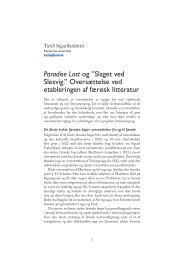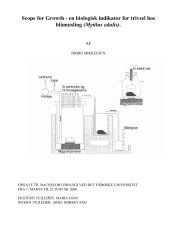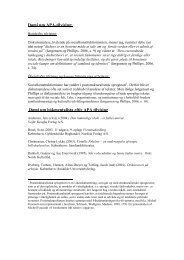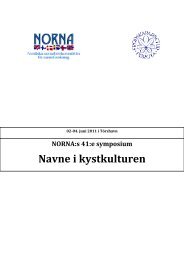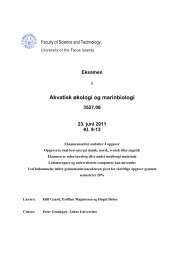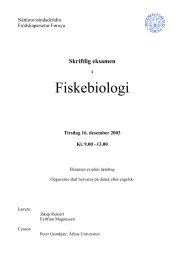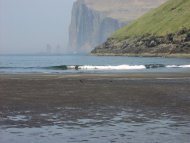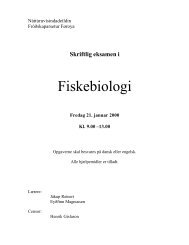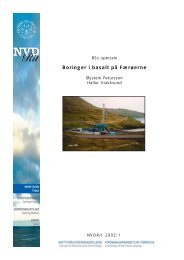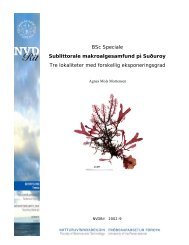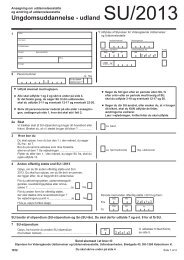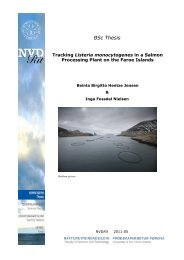Exam in Aquatic Ecology and Marine Biology 3527.11 29 February ...
Exam in Aquatic Ecology and Marine Biology 3527.11 29 February ...
Exam in Aquatic Ecology and Marine Biology 3527.11 29 February ...
Create successful ePaper yourself
Turn your PDF publications into a flip-book with our unique Google optimized e-Paper software.
Faculty of Science <strong>and</strong> Technology<br />
University of the Faroe Isl<strong>and</strong>s<br />
<strong>Exam</strong><br />
<strong>in</strong><br />
<strong>Aquatic</strong> <strong>Ecology</strong> <strong>and</strong> Mar<strong>in</strong>e <strong>Biology</strong><br />
<strong>3527.11</strong><br />
<strong>29</strong> <strong>February</strong> 2012<br />
Kl. 9-13<br />
The exam <strong>in</strong>cludes 4 tasks<br />
The students are allowed to answer <strong>in</strong> Danish, Norwegian, Swedish or English<br />
No textbook or other material is allowed dur<strong>in</strong>g the exam<br />
Calculator <strong>and</strong> university computers can be used<br />
The average grade for the written assignments through the semester account<br />
for 20% of the f<strong>in</strong>al grade for the course<br />
Teachers: Eilif Gaard, Eyðf<strong>in</strong>n Magnussen, Høgni Debes <strong>and</strong> Gunnvør á Norði<br />
Censor: Benni W. Hansen, Roskilde Universitet<br />
1
Opgave 1 (25%)<br />
I fiskebest<strong>and</strong>e er der alm<strong>in</strong>deligvis store sv<strong>in</strong>gn<strong>in</strong>ger i populationsstørrelserne, både med<br />
hensyn til, hvordan populationen varierer gennem året og fra år til år.<br />
Disse variationer har stor betydn<strong>in</strong>g for fiskeriet og hvor meget der bliver fisket hvert år.<br />
I lærebogen bliver der gennemgået fire hypoteser, der kan være med til at forklare<br />
sv<strong>in</strong>gn<strong>in</strong>gerne i fiskebest<strong>and</strong>e. De fire hypoteser er følgende:<br />
1. Sult hypotesen (starvation hypothesis)<br />
2. Predation hypotesen (predation hypothesis)<br />
3. Advection hypotesen (advection hypothesis)<br />
4. Vækst hypotesen (growth hypotesis)<br />
Forklar pr<strong>in</strong>cippet i hver af disse fire hypoteser og hvordan og hvorfor de påvirker<br />
fiskebest<strong>and</strong>ene.<br />
-------------------------------------------------------<br />
Fish stocks generally show high fluctuation <strong>in</strong> the stocks size, both with regard to how the<br />
population varies throughout the year <strong>and</strong> from one year to another.<br />
These variations are important for the fishery <strong>and</strong> the amount of fish caught <strong>in</strong> a year. In<br />
the textbook, four hypotheses are formulated expla<strong>in</strong><strong>in</strong>g these fluctuations. The four<br />
hypotheses are:<br />
1. Starvation hypothesis<br />
2. Predation hypothesis<br />
3. Advection hypothesis<br />
4. Growth hypothesis<br />
Expla<strong>in</strong> the pr<strong>in</strong>ciple of each of these four hypotheses <strong>and</strong> how <strong>and</strong> why they affect fish<br />
stocks.<br />
Opgave 2 (15%)<br />
a) Beskriv strømn<strong>in</strong>gsmønstret i tværsnittet af et v<strong>and</strong>løb (evt. suppleret med en<br />
tegn<strong>in</strong>g).<br />
b) Gør specielt rede for strømn<strong>in</strong>gerne i nærheden af bunden. På hvilke måder<br />
påvirker strømn<strong>in</strong>gshastigheden organismerne i v<strong>and</strong>løbet og hvordan er<br />
organismerne tilpasset til strømmende v<strong>and</strong>?<br />
c) Diskuter de faktorer, der påvirker oxygenmængden i færøske v<strong>and</strong>løb og hvilken<br />
betydn<strong>in</strong>g oxygenmængden kan have for dyrelivet i v<strong>and</strong>løbet.<br />
--------------------------------------------<br />
a) Describe the flow pattern <strong>in</strong> the cross section of a river (possibly supplemented by<br />
a figure/draw<strong>in</strong>g).<br />
2
) Expla<strong>in</strong> especially the water-flows near the bottom. How does the water velocity<br />
affect the organisms that are liv<strong>in</strong>g <strong>in</strong> the stream, <strong>and</strong> how are the organisms<br />
adapted to this?<br />
c) Discuss the factors that <strong>in</strong>fluence the oxygen contents <strong>in</strong> Faroese streams <strong>and</strong> the<br />
importance of oxygen level for wildlife <strong>in</strong> the stream.<br />
Opgave 3 (35%)<br />
På figur 1 ses en skematisk illustration af tre forskellige mar<strong>in</strong>e pelagiske fødekæder<br />
karakteristisk for tre forskellige mar<strong>in</strong>e systemer. Organismerne<br />
der repræsenterer de forskellige trofiske niveauer, er kun udvalgte eksempler af mange<br />
mar<strong>in</strong>e arter, der kan forekomme i de pågældende niveauer.<br />
a) Forklar i hovedtræk forskellene på fødekæderne i henholdsvis eksemplerne fra<br />
åbenthav (I), kont<strong>in</strong>entalsokkel (II) og upwell<strong>in</strong>g område (III).<br />
b) Hvordan vil typiske hydrografiske og nær<strong>in</strong>gssaltmæssige forhold i v<strong>and</strong>søjlen<br />
påvirke primærproduktionerne i de tre systemer?<br />
c) Hvor meget tror du, at henholdsvis ny og regenereret primærproduktion relativt<br />
betyder i de tre systemer, og hvorfor?<br />
d) Hvilke forskelle er der i fytoplanktonets arts- og størrelsessammensætn<strong>in</strong>g i de<br />
tre områder, og hvilke forskelle i miljøet kan antages at ligge til grund for<br />
forskellene?<br />
e) Hvilken betydn<strong>in</strong>g har fytoplanktonets arts- og størrelsessammensætn<strong>in</strong>g i de<br />
tre systemer for transport af det producerede organiske materiale gennem<br />
fødekæderne?<br />
f) Ranger systemerne i forhold til hvor produktive de er. Begrund svaret.<br />
3
Figur 1. Sammenlign<strong>in</strong>g af fødekæder i tre forskellige mar<strong>in</strong>e systemer. (Food cha<strong>in</strong>s <strong>in</strong><br />
three different mar<strong>in</strong>e systems)<br />
---------------------------------------------------<br />
Figure 1 shows a schematic illustration of three different pelagic food cha<strong>in</strong>s from three<br />
different mar<strong>in</strong>e systems. The organisms<br />
represent<strong>in</strong>g the different trophic levels are only a selection of many<br />
mar<strong>in</strong>e species that may be present <strong>in</strong> the respective levels.<br />
a) Expla<strong>in</strong> the ma<strong>in</strong> differences between the food cha<strong>in</strong>s <strong>in</strong> the three examples:<br />
open sea (I), cont<strong>in</strong>ental shelf (II) <strong>and</strong> the upwell<strong>in</strong>g area (III).<br />
b) How will typical hydrographic <strong>and</strong> nutrient conditions <strong>in</strong> the water column<br />
affect primary production <strong>in</strong> the three systems?<br />
c) What do you th<strong>in</strong>k the relative importance of new <strong>and</strong> regenerated primary<br />
production is <strong>in</strong> the three systems, <strong>and</strong> why?<br />
d) What are the differences <strong>in</strong> phytoplankton species <strong>and</strong> size composition <strong>in</strong> the<br />
three areas, <strong>and</strong> which environmental factors can be assumed to underlie the<br />
differences?<br />
e) What is the importance of the phytoplankton species <strong>and</strong> size composition <strong>in</strong><br />
the three systems for transport of the produced organic material through the food<br />
cha<strong>in</strong>s?<br />
f) Rate the three systems accord<strong>in</strong>g to how productive they are. Justify your<br />
answer.<br />
4
Opgave 4 (25%)<br />
a) Gør rede for henholdsvis kompensationsdybde og den kritiske dybde<br />
b) Hvilke miljøforhold kan tænkes at afgøre starten og udvikl<strong>in</strong>gen af en<br />
forårsopblomst<strong>in</strong>g?<br />
c) Efter forårsopblomstr<strong>in</strong>gen kommer typisk en sommersituation med lavere<br />
primærproduktion. Hvilke miljøforhold ligger typisk til grund for denne<br />
udvikl<strong>in</strong>g?<br />
d) Hvilke grupper/størrelser af fytoplankton dom<strong>in</strong>erer typisk i de to situationer,<br />
henholdsvis forårsopblomstr<strong>in</strong>gen og om sommeren? Hvilke årsager kan<br />
tænkes at være til dette skifte i fytoplanktonets arts- og<br />
størrelsessammensætn<strong>in</strong>g?<br />
--------------------------------------------<br />
a) Expla<strong>in</strong> the compensation depth <strong>and</strong> the critical depth<br />
b) Which environmental conditions are likely to determ<strong>in</strong>e the onset <strong>and</strong><br />
development of a phytoplankton spr<strong>in</strong>g-bloom?<br />
c) After the spr<strong>in</strong>g-bloom comes typically a summer situation with lower primary<br />
production. Which environmental conditions do typically determ<strong>in</strong>e this<br />
development?<br />
d) Which groups / sizes of phytoplankton typically dom<strong>in</strong>ate <strong>in</strong> the two situations,<br />
respectively, the spr<strong>in</strong>g bloom <strong>and</strong> dur<strong>in</strong>g summer? What reasons might be for<br />
this shift <strong>in</strong> phytoplankton species <strong>and</strong> size composition?<br />
5



